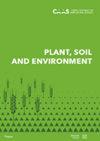轮作和深埋耕作轮作影响土壤碳氮固存和作物产量
IF 1.8
3区 农林科学
Q1 AGRONOMY
引用次数: 7
摘要
长期单耕造成土地质量严重恶化,作物产量下降。轮作可以缓解长期单一耕作带来的问题。然而,不同轮作方式的影响仍然非常有限。在华北平原进行了轮作试验,研究了轮作对土壤有机碳(SOC)、土壤总氮(STN)和作物产量的影响。共有八种处理,有两个主要因素:耕作实践(四种类型:旋耕(R,2002-2017)、深松耕作(S,2002~2017)、旋松转深松(RS,2015~2017)和深松转旋耕(SR,2015-2017))和秸秆管理(两种类型:秸秆还田(F)和秸秆还田(0))。RSF处理的SOC最高,为12.53 g/kg。与RF相比,RSF显著增加了41.4%的SOC,而与SF相比,SRF显著降低了11.1%的SOC。此外,RSF使STN含量比RF下显著增加21.7%。与SF相比,SRF促进了土壤氮在0~20cm土层中的均匀分布。在处理中,RSF处理产生的SOC存量(SOCS)和STN存量(STNS)最高,分别为67.68t/ha和6.63t/ha。与RF处理相比,RSF处理显著提高了SOCS,提高了31.7%。两种轮作处理的STNS在RSF下比RF增加了13.3%,在SRF下比SF增加了2.3%。2016年,RSF处理的年产量最高,为19.80吨/公顷。2017年,SF处理的年产量最高,为21.37吨/公顷,其次是RSF处理,为20.94吨/公顷。总之,长期旋耕后深松结合秸秆还田(RSF)可以显著提高SOC、STN和作物产量。轮作深松结合秸秆还田是改善华北平原土壤质量、提高作物产量的有效措施。本文章由计算机程序翻译,如有差异,请以英文原文为准。
Rotary and subsoiling tillage rotations influence soil carbon and nitrogen sequestration and crop yield
Long-term single tillage causes serious deterioration of land quality and reduction of crop yield. Tillage rotation can alleviate the problems caused by long-term single tillage. However, the effects of different tillage rotations are still very limited. A tillage rotation experiment was conducted in the North China Plain to evaluate the impacts of tillage rotation on soil organic carbon (SOC), soil total nitrogen (STN) and crop yield. There were eight treatments with two main factors: tillage practice (four types: rotary tillage (R, 2002–2017), subsoiling tillage (S, 2002–2017), rotary to subsoiling tillage (RS, 2015–2017) and subsoiling to rotary tillage (SR, 2015–2017)) and straw management (two types: straw return (F) and straw removal (0)). RSF treatment yielded the highest SOC, at 12.53 g/kg. RSF significantly increased SOC by 41.4% compared to RF, while SRF significantly reduced SOC by 11.1% compared to SF. In addition, RSF significantly increased STN content by 21.7% compared with that under RF. Compared with SF, SRF promoted the uniform distribution of soil nitrogen in the 0–20 cm soil layer. Among the treatments, the RSF treatment yielded the highest SOC stock (SOCS) and STN stock (STNS), which were 67.68 t/ha and 6.63 t/ha, respectively. Compared with RF treatment, RSF treatment greatly increased SOCS, by 31.7%. Both tillage rotation treatments increased STNS by 13.3% under RSF compared to RF, and by 2.3% under SRF compared to SF. In 2016, the annual yield was highest under RSF treatment at 19.80 t/ha. In 2017, the annual yield was highest under SF treatment at 21.37 t/ha, and next highest under RSF at 20.94 t/ha. In summary, long-term rotary tillage followed by subsoiling tillage combined with straw return (RSF) can significantly increase SOC, STN and crop yield. The rotation of rotary tillage to subsoiling tillage combined with the straw return is an effective measure for improving soil quality and increasing crop yields in the North China Plain.
求助全文
通过发布文献求助,成功后即可免费获取论文全文。
去求助
来源期刊

Plant, Soil and Environment
Agronomy, Soil Science-农艺学
CiteScore
4.80
自引率
4.20%
发文量
61
审稿时长
2.4 months
期刊介绍:
Experimental biology, agronomy, natural resources, and the environment; plant development, growth and productivity, breeding and seed production, growing of crops and their quality, soil care, conservation and productivity; agriculture and environment interactions from the perspective of sustainable development. Articles are published in English.
 求助内容:
求助内容: 应助结果提醒方式:
应助结果提醒方式:


